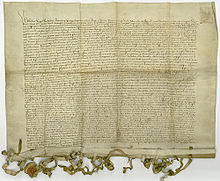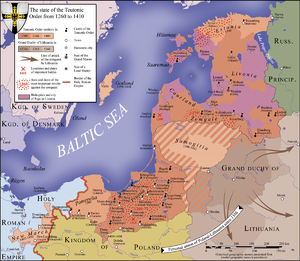Peace of Thorn (1411)

The (First) Peace of Thorn was a
Gollub War in 1422, to sign the Treaty of Melno that solved the territorial disputes. However, large war reparations
were a significant financial burden on the Knights, causing internal unrest and economic decline. The Teutonic Knights never recovered their former might.
Background

In May 1409, an
Grand Master, wanted to continue fighting and attempted to recruit new crusaders. However, the Teutonic Council preferred peace and both sides agreed to a truce, effective between 10 December 1410 and 11 January 1411.[6] Three-day negotiations in Raciąż between Jogaila and von Plauen broke down and Teutonic Knights invaded Dobrzyń Land again.[6] The incursion resulted in a new round of negotiations that ended[citation needed] with the Peace of Thorn signed on 1 February 1411.[7]
Terms
The borders were returned to their pre-1409 state with exception of
Jogaila and Lithuanian Grand Duke Vytautas. After their deaths, Samogitia was to return to the Knights. (Both rulers were at the time aged men.[9]) In the south, the Dobrzyń Land, captured by the Knights during the war, was ceded back to Poland. Thus, the Knights suffered virtually no territorial losses – a great diplomatic achievement after the crushing defeat in the Battle of Grunwald.[8][10] All sides agreed that any future territorial disputes or border disagreements would be resolved via international mediation. Borders were open for international trade, which was more beneficial to Prussian cities.[9] Jogaila and Vytautas also promised to convert all remaining pagans in Lithuania, which officially converted to Christianity in 1386, and Samogitia, which was not yet officially converted.[8]
After the Battle of Grunwald, Poland–Lithuania held some 14,000 captives.King of England.[14]
Aftermath
In order to raise the money needed to pay the ransom, Grand Master
Sigismund of Hungary to ensure their continued support to the Teutonic cause.[15] Tax records indicated that harvest was modest in those years and that many communities fell three years behind their taxes.[16]
Soon after the conclusion of the peace, disagreements arose regarding the ill-defined borders of Samogitia. Vytautas claimed that all territory north of the
Neman River, including port city Memel (Klaipėda), was part of Samogitia and thus should be transferred to the Grand Duchy of Lithuania.[17] In March 1412, Sigismund of Hungary agreed to mediate reduction to the third installment, demarcation of the Samogitian border, and other matters. The delegations met in Buda (Ofen), residence of Sigismund, where lavish feasts, tournaments, and hunts were organized. The celebrations included wedding of Cymburgis of Masovia, Jogaila's niece, to Ernest, Duke of Austria.[18] In August 1412, Sigismund announced that the Peace of Thorn was proper and fair[19] and appointed Benedict Makrai to investigate the border claims. The installments were not reduced and the last payment was made on time in January 1413.[20] Makrai announced his decision in May 1413, allotting the entire northern bank, including Memel, to Lithuania.[21] The Knights refused to accept this decision and the inconclusive Hunger War broke out in 1414. The negotiations continued at the Council of Constance and the dispute was not resolved until the Treaty of Melno in 1422.[citation needed
]
Overall, the Peace of Thorn had a negative long-term impact on Prussia. By 1419, 20% of Teutonic land lay abandoned and its currency was
Thirteen Years' War (1454–66)
).
References
Citations
- ^ Turnbull 2003, p. 20
- ^ Ivinskis 1978, p. 336
- ^ Ivinskis 1978, p. 342
- ^ Turnbull 2003, p. 75
- ^ Urban 2003, p. 166
- ^ a b Turnbull 2003, p. 77
- ISBN 9780300101287.
- ^ a b c d e Turnbull 2003, p. 78
- ^ a b c Urban 2003, p. 175
- ^ Davies 2005, p. 98
- ^ Turnbull 2003, p. 68
- ^ Turnbull 2003, p. 69
- ^ Pelech 1987, pp. 105–107
- ^ Christiansen 1997, p. 228
- ^ Urban 2003, pp. 176, 189
- ^ Urban 2003, p. 188
- ^ Ivinskis 1978, p. 345
- ^ Urban 2003, p. 191
- ^ Urban 2003, p. 192
- ^ Urban 2003, p. 193
- ^ Ivinskis 1978, pp. 346–347
- ^ Stone 2001, p. 17
- ^ Christiansen 1997, p. 230
Sources
- Christiansen, Eric (1997), The Northern Crusades (2nd ed.), Penguin Books, ISBN 0-14-026653-4
- ISBN 978-0-19-925339-5
- Ivinskis, Zenonas (1978), Lietuvos istorija iki Vytauto Didžiojo mirties (in Lithuanian), Rome: Lietuvių katalikų mokslo akademija, LCCN 79346776
- Pelech, Markian (1987), "W sprawie okupu za jeńców krzyżackich z Wielkiej Wojny (1409–1411)", Zapiski Historyczne (in Polish), 2 (52), archived from the original on 28 September 2011
- Stone, Daniel (2001), The Polish-Lithuanian state, 1386–1795, ISBN 978-0-295-98093-5
- ISBN 978-1-84176-561-7
- ISBN 0-929700-25-2
External links
 Works related to Peace of Thorn at Wikisource (in Latin)
Works related to Peace of Thorn at Wikisource (in Latin)
